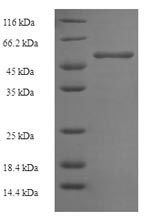The recombinant Mouse Otc was expressed with the amino acid range of 33-354. The calculated molecular weight for this Otc protein is 52.1 kDa. This Otc protein is produced using e.coli expression system. The Otc coding gene included the N-terminal 6xHis-SUMO tag, which simplifies the detection and purification processes of the recombinant Otc protein in following stages of expression and purification.
The mouse ornithine transcarbamylase, mitochondrial (Otc) is an essential enzyme involved in the urea cycle, a metabolic pathway that facilitates the detoxification of ammonia, a byproduct of protein metabolism. Otc catalyzes the conversion of ornithine and carbamoyl phosphate into citrulline, a crucial step in the urea cycle. This process occurs within the mitochondria of liver cells and is vital for maintaining nitrogen balance in the body. Dysfunction of Otc can lead to hyperammonemia, a condition characterized by elevated ammonia levels, which can be toxic to the central nervous system. Research related to Otc primarily focuses on understanding its role in the urea cycle, exploring potential therapeutic interventions for urea cycle disorders, and investigating its broader implications in metabolic regulation.






